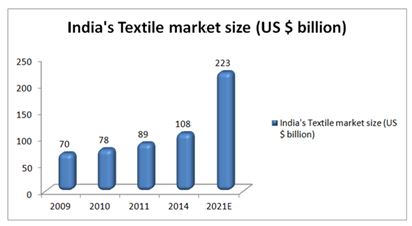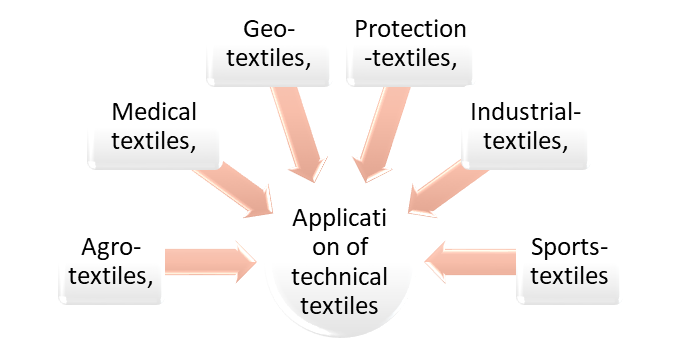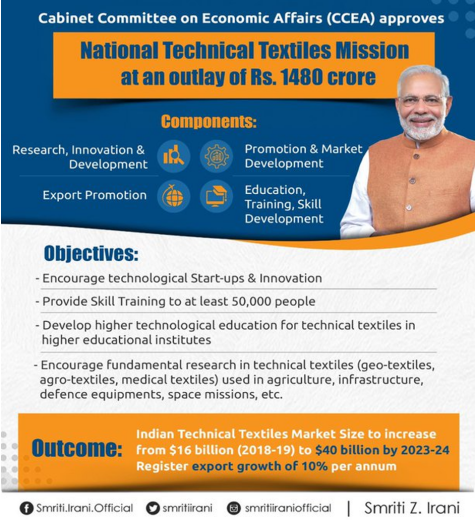CONTENTS
- Technical Textiles
- Gender Samvaad
Technical Textiles
Focus: GS-III: Industry and Infrastructure (Textile Industry, Government Policies and Initiatives, Industrial Policy)
Why in News?
The Ministry of Textiles in partnership with Confederation of Indian Industries (CII) organized a full-day International Conference on Technical Textiles with the theme: Creating the Winning Leap in Technical Textiles.
Significance of Textile Sector in India

- The Textile Sector accounts for 7% of India’s manufacturing output, 2% of GDP, 12% of exports and employs directly and indirectly about 10 crore people.
- Owing to the abundant supply of raw material and labour, India is the largest producer of cotton (accounting for 25% of the global output) and second-largest producer of textiles and garments and man-made fibres (polyester and viscose).
- India has the unique advantage of the entire value chain for textile production present within the country vis-à-vis other competing nations which have to import fibre, yarn and fabric to meet their requirement for garment production.
- With direct and indirect employment of close to 105 million people, this industry is the second largest employment generator in the country, next only to agriculture.
- More significantly, women constitute 70% of the workforce in garment manufacturing and about 73% in Handloom.
- The domestic textile and apparel production is approx US$ 140 Bn including US$ 40 Bn of Textiles and Apparel export.
- Availability of almost all types of raw materials, existence of total value chain, young demography of India, entrepreneurial mindset of industry leaders, continuous support of Government, technology up gradation, focus on innovation and strong presence of support industries contribute to helping this sector grow at a healthy pace.
About PM Mega Investment Textiles Parks (PM MITRA) scheme
- The PM Mega Investment Textiles Parks (PM MITRA) scheme was launched in 2020 with a plan to establish Seven textile parks which will have a world-class infrastructure over three years.
- These parks will also have plug-and-play facilities (business facilities will be available ready-made) to help create global champions in exports in the textile sector.
Aims and Significance of MITRA
- The Mega Investment Textiles Parks (MITRA) Scheme aims to enable the textile industry to become globally competitive and boost exports.
- The scheme also aims to boost employment generation within the textile sector and also attract large investment.
- The scheme was launched in addition to the Production Linked Incentive (PLI) Scheme.
- The scheme will create a level-playing field for domestic manufacturers in the international textiles market.
- It will also pave the way for India to become a global champion of textiles exports across all segments.
- MITRA will lead to increased investments and enhanced employment opportunities with the support from the Production Linked Incentive (PLI) scheme.
About the PLI Scheme for textiles sectors
Production Linked Incentive (PLI) Scheme for Textiles is specially focused at high value and expanding MMF and Technical Textiles segments of Textiles Value Chain. Incentives worth Rs. 10,683crore will be provided over five years for manufacturing notified products of MMF Apparel, MMF Fabrics and segments/products of Technical Textiles in India.
Expected Benefits
- The scheme could aid in the creation of 7.5 lakh direct jobs. The textile sector is an employment intensive sector and the investment in the textile sector would have a multiplier effect on the Indian economy especially in job creation.
- Two-thirds of India’s textile exports now are cotton-based whereas 66-70% of world trade in textiles and apparel is MMF-based and technical textiles. The PLI incentives aim to boost investment in new capacities in man-made fibre (MMF) apparel, MMF fabrics, and 10 segments or products of technical textiles.
- India’s focus on the manufacture of textiles in the MMF sector is expected to help boost its ability to compete globally in the textiles market.
- Given that priority would be given for investment in aspirational districts, tier-three, tier-four towns and rural areas, the new scheme would promote balanced regional development.
- The textiles industry predominantly employs women, therefore, the scheme will empower women and increase their participation in the formal economy.
- In addition, priority will be given for investment in Aspirational Districts, Tier 3, Tier 4 towns, and rural areas and due to this priority, Industry will be incentivized to move to backward areas. This scheme will positively impact especially States like Gujarat, UP, Maharashtra, Tamil Nadu, Punjab, AP, Telangana, Odisha etc.
About Technical Textiles
- The Technical Textiles are defined as Textile material and products manufactured primarily for their Technical performance and functional properties rather than aesthetic and decorative characteristics.
- The Technical textiles include textiles for automotive applications, medical textiles (e.g., implants), geotextiles (reinforcement of embankments), agrotextiles (textiles for crop protection), and protective clothing (e.g., heat and radiation protection for fire fighter clothing, molten metal protection for welders, stab protection and bulletproof vests, and spacesuits).

Significance and Potential Applications of Technical Textiles
- The Technical Textiles are being used globally for last several decades. These materials have provided innovative projects.
- Even while Technical Textiles have been extensively used in developed as well as many developing countries, India has yet to capitalize the technical, economical and environmental benefits on large scale.
- The Various parts of India are subjected to floods and environmental degradation. In some of the terrains, the flood management and control can rely on Technical Textiles tubes, containers and bags.
- The Technical Textiles have been found to perform better than concrete as water protection component because of permeability, flexibility and ease of underwater placement.
About National Technical Textiles Mission
- The Cabinet Committee on Economic Affairs (CCEA) approved the establishment of a National Technical Textiles Mission to help India position itself as a “global leader“ in technical textiles.
- The Cabinet has approved a total outlay of Rs 1,480 crore for the project, which will be implemented over four years (2020-2024) and aims to promote research, export and skill development in this sector.
- An Export Promotion Council for Technical Textiles will be set up for export promotion of technical textiles and ensuring 10% average growth in exports per year upto 2023-24.

Objectives:
- The main aim is to get India the highest position in Technical Textiles at a global level
- This mission also aims at improving the penetration level of the technical textiles in the country. It must also be noted that the penetration level of technical textiles is low in India at 5-10%, against 30-70% in advanced countries.
- The authorities aim at increasing the global market for Indian technical textiles
- To simplify the objectives of the mission, it has been divided into four component as well
- The Mission will focus on the usage of technical textiles in various flagship missions, programmes of the country including strategic sectors
Gender Samvaad
Focus: GS II- Government policies and intervention, Prelims
Why in News?
Over 3000 State Mission staff and Self-Help Group (SHG) members logged in from 34 states to attend the third edition of ‘Gender Samwaad’ organised by the Deendayal Antyodaya Yojana-National Rural Livelihoods Mission (DAY-NRLM), Ministry of Rural Development on the 11th of March 2022.
Details:
- It is a national virtual initiative under the DAY-NRLM to generate greater awareness on the mission’s interventions across the country with a gender lens.
- The theme for this edition was ‘Promotion of food and nutrition security through women’s collectives’.
- The event was organized as a part of Ministry’s Iconic Week celebration theme ‘Naye Bharat ki Naari’ under Amrit Mahotsava.
About Gender Samvad:
- It is a joint attempt between DAY-NRLM and the Initiative for What Works to Advance Women and Girls in the Economy (IWWAGE) to create a common platform to share experiences emerging from this effort, was organised today by the Ministry of Rural Development, Govt. of India.
- The attempt is to generate greater awareness on gender related interventions under DAY-NRLM across the country and best practices, with a focus on hearing voices from the states and the field.
Gender Samvaad provides states with opportunities to:
- Understand best practices/initiatives that other states have been undertaking to improve women’s agency (e.g. facilitating women’s access to land rights, their engagement in farmer producer organizations (FPOs), best practices around Food, Nutrition, Health and Water and Sanitation (FNHW), in establishing strong institutions for public service delivery, and in protecting and providing redress to vulnerable groups within women (e.g. to victims of witch hunting));
- Understand gender interventions globally;
- Engage with experts and other colleagues on suggestions regarding how to handle issues/implementation barriers;
- Contribute to creation of a ‘gender repository’ with resource materials on best practices for gender interventions across the country/other countries; and
- Build advocacy around the need to focus on gender issues across SRLMs and the NRLM.




